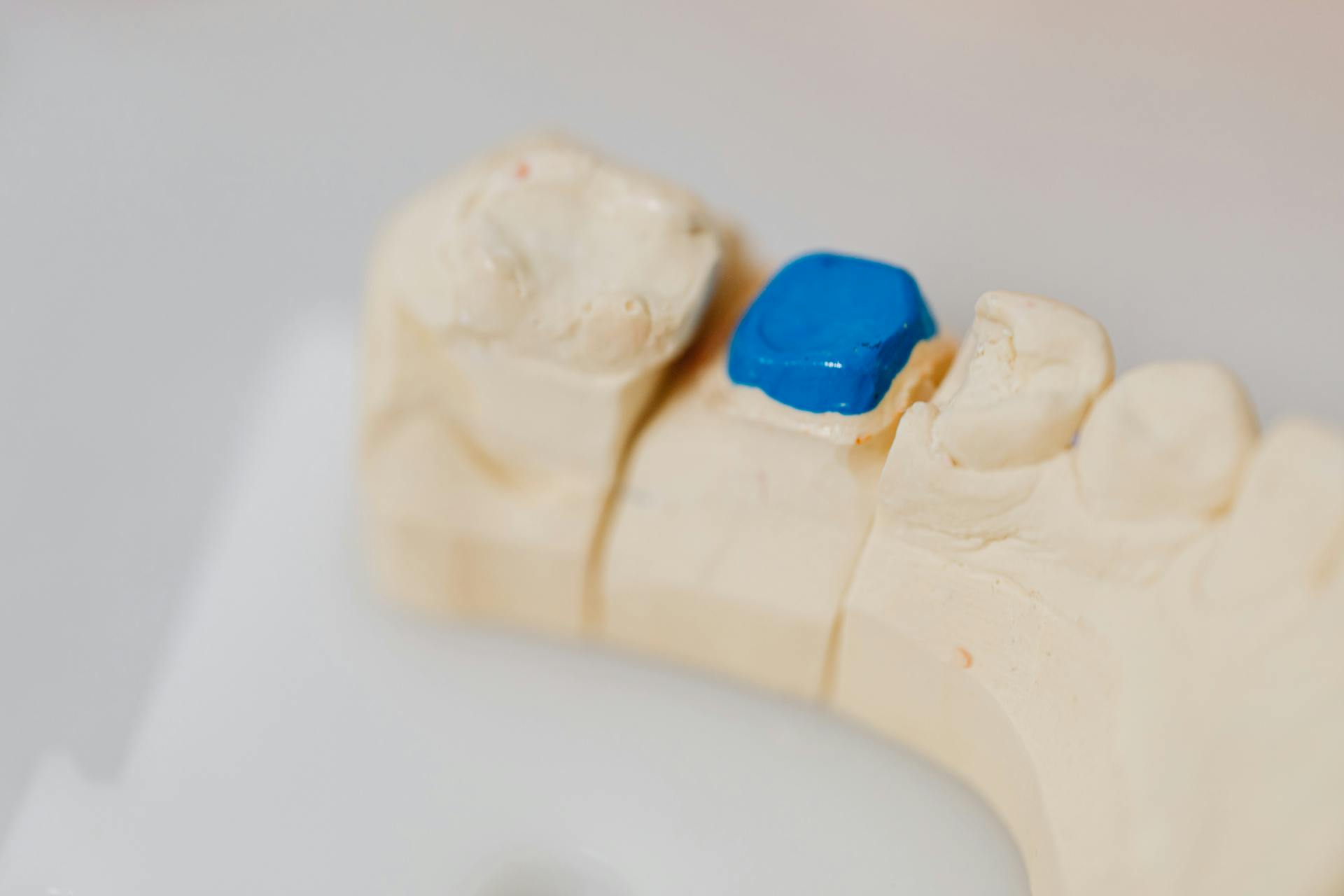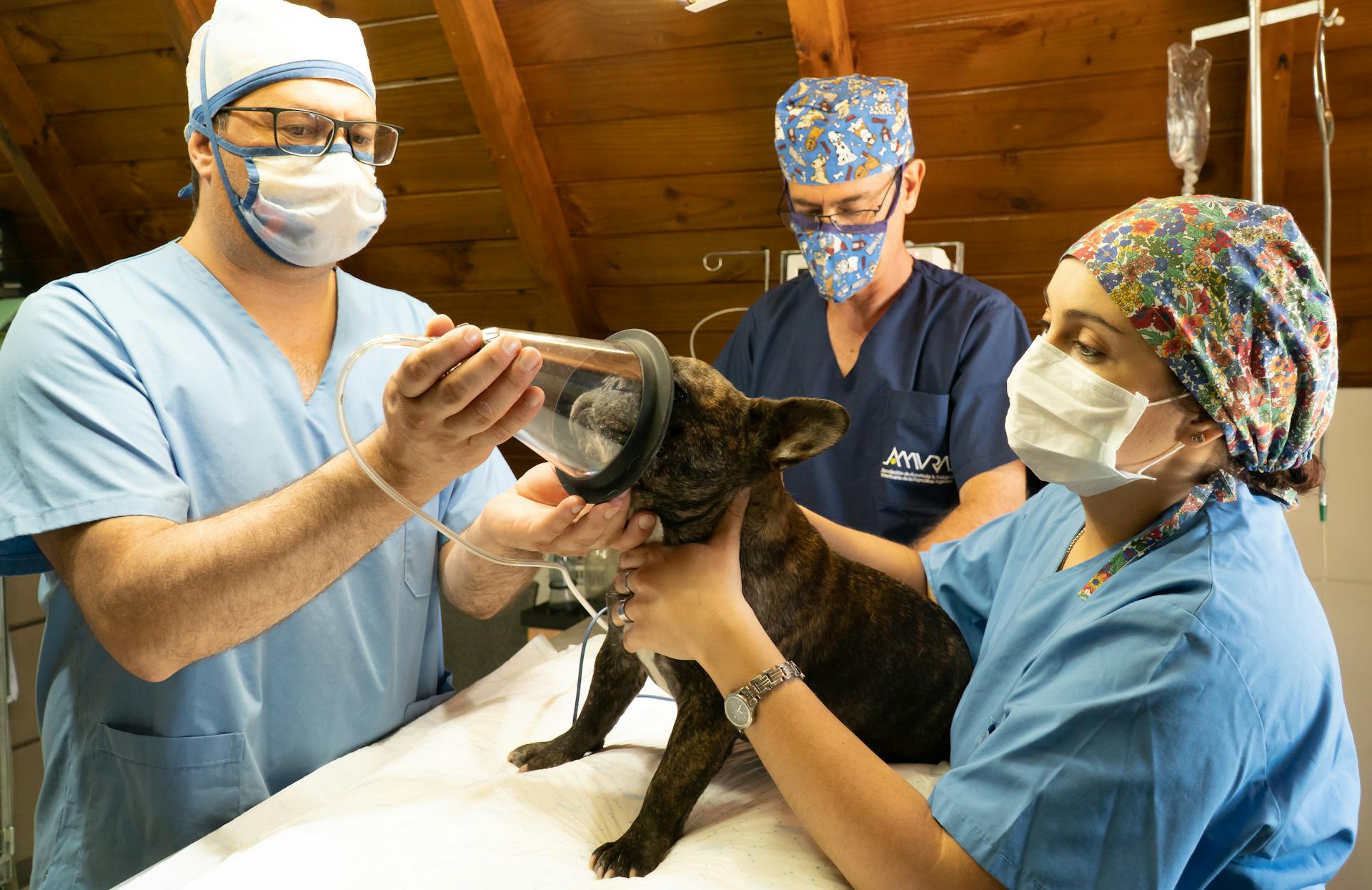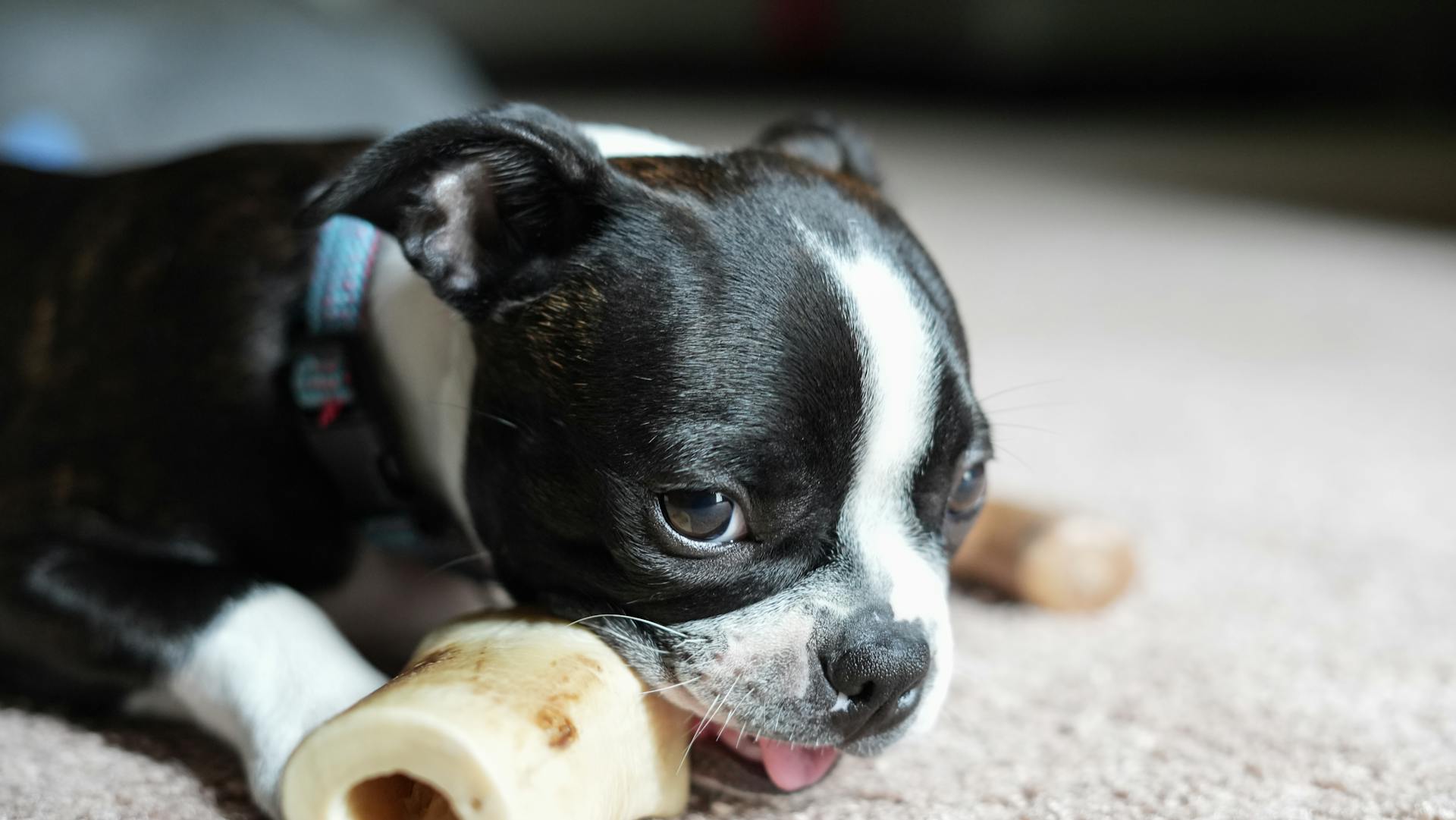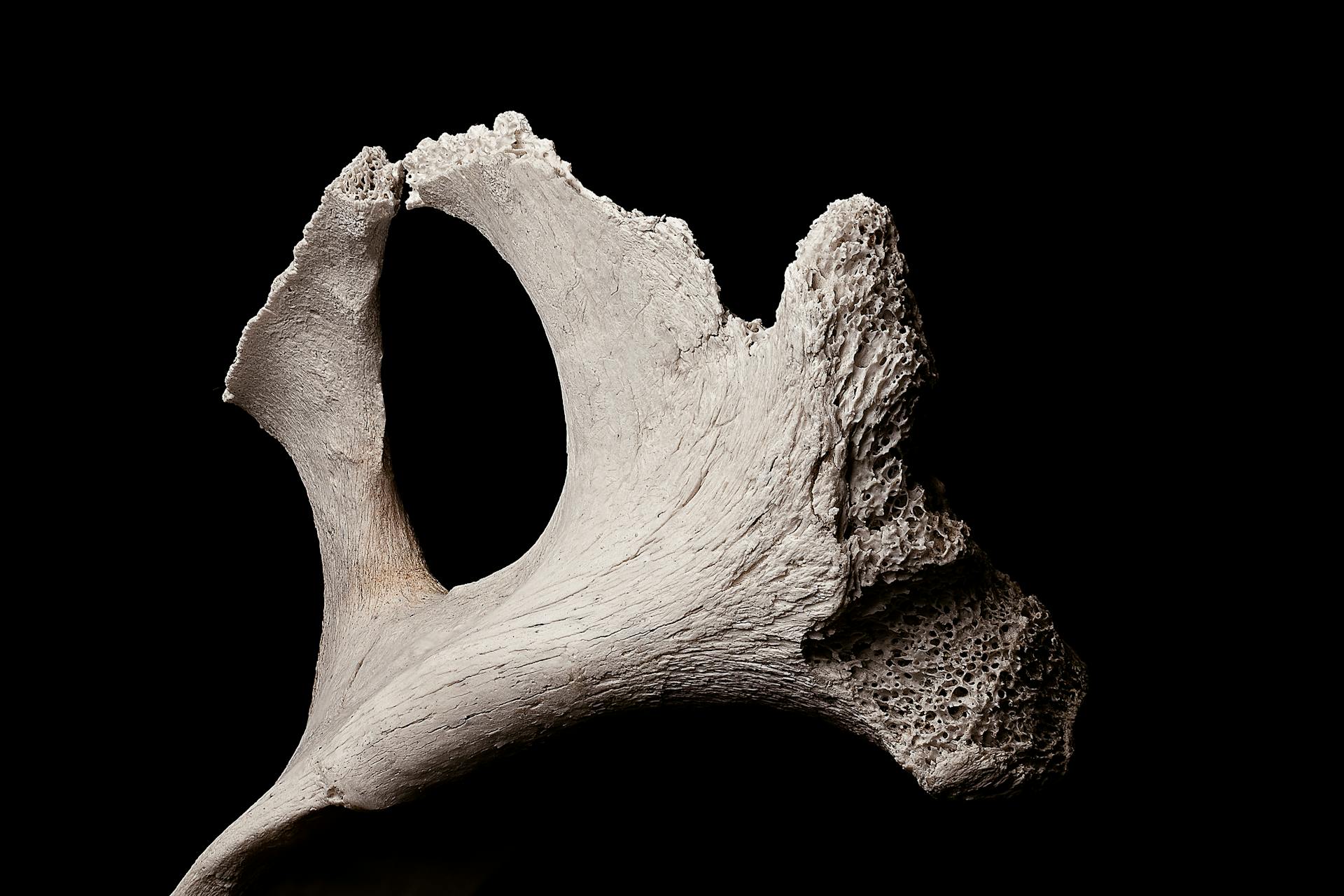
Bone loss in the mouth is a common issue that affects millions of people worldwide. It occurs when the jawbone that supports the teeth begins to deteriorate.
This can happen due to various reasons, including gum disease, tooth loss, and even genetics. In fact, research suggests that gum disease is the leading cause of tooth loss in adults.
Bone loss can lead to a range of problems, including loose teeth, difficulty chewing, and changes in facial appearance. It can also affect a person's self-esteem and overall quality of life.
In severe cases, bone loss can lead to the collapse of the upper or lower jaw, causing a condition known as facial collapse. This can make everyday activities, such as eating and speaking, extremely challenging.
Worth a look: Benadryl for Tracheal Collapse
What is Bone Loss?
Bone loss in the mouth is a common issue that affects millions of people worldwide.
Bone loss occurs when the body breaks down bone tissue faster than it can be replaced.
This process can be caused by a lack of stimulation to the jawbone, which can happen when teeth are missing or not properly aligned.
The jawbone needs stimulation to stay healthy, just like any other part of the body.
Without this stimulation, the bone begins to deteriorate, leading to bone loss.
Bone loss in the mouth can also be caused by gum disease, which is a bacterial infection that damages the gums and bone supporting the teeth.
Gum disease can be prevented with good oral hygiene habits, such as brushing and flossing regularly.
Causes and Risk Factors
Bone loss in the mouth can be caused by a variety of factors.
Missing teeth or advanced periodontitis are common causes of bone loss around teeth.
Smoking is a significant risk factor for bone loss in the mouth, increasing the susceptibility to gum disease and bone loss, and reducing the effectiveness of treatment.
Periodontal disease, also known as gum disease, is a major contributor to dental bone loss, caused by plaque buildup on teeth due to improper brushing and flossing.
Smoking can also lead to bone loss in the jaws by destroying the network that delivers blood to the gums, and changing the production of enzymes that work to maintain the gums.
Getting older is a natural cause of dental bone loss, as the mass of the jawbone tends to decrease over time.
Smoking, poor nutrition, and some serious medical conditions can increase the susceptibility to bone loss in the mouth.
Tooth grinding, or bruxism, can cause bone loss in many patients, especially if they aren't brushing and flossing correctly or are a smoker.
Losing one or more teeth can lead to bone loss in the jaw, as the bone that was around the missing tooth can start to recede.
Bone loss in the jaw can also be caused by jaw lesions, which may be malignant tumors or benign cysts that over time will erode the bone.
If this caught your attention, see: Dog with Lead in Mouth
Symptoms and Signs
Symptoms of bone loss in the mouth can be quite subtle, but they can also be quite painful. Changes in your bite and facial structure are a common sign, and if you wear dentures, bone loss can cause them to feel loose or fit differently.
Discomfort when chewing is another symptom you may experience. This can be due to the bone loss causing your teeth to shift or loosen.
Shifting or loosening of your teeth is a clear indication of bone loss. This can be a gradual process, but it's essential to catch it early.
Shrinking gums are another sign of bone loss. This can lead to other issues, such as bad breath and pain when chewing.
Here are some common signs of bone loss:
- Gap or gaps opening up between the teeth
- Bad breath
- Mobile teeth
- Swollen or bleeding gums
- Gum recession
Certain changes in your facial features can also indicate jaw bone loss. These may include a collapsed mouth, a pointed chin, or wrinkles around the mouth.
Consequences and Complications
Losing bone in your jaw can have some serious consequences. Significant jaw bone loss can alter your facial features, making you appear much older than your chronological age.
A condition called facial collapse can occur if jawbone atrophy is left untreated, causing the mouth to fall backwards into the face and the chin to become more pointed. Facial muscles weaken, leading to premature wrinkling around the mouth and a thinning of the lips.
Explore further: Lump on inside of Mouth on Jaw Bone
Jawbone loss can also cause your remaining teeth to shift out of place, leading to a range of issues including headaches, facial and jaw pain, difficulty speaking and eating, inadequate nutrition, and sinus expansion.
Here are some of the potential complications of jaw bone loss:
- Headaches
- Facial and jaw pain
- Difficulty speaking and eating
- Inadequate nutrition
- Sinus expansion
Jaw Pain Causes
Jaw pain can be a real nuisance, and understanding its causes can help you address it effectively.
Tooth loss can lead to jaw pain due to the loss of bone and tissue in the jaw.
Smoking can also contribute to jaw pain, as it affects the density of bone in all areas of the body, including the jaw.
Gum disease is another common cause of jaw pain, as it damages the tissue and bone that support your teeth.
The good news is that addressing the underlying causes of jaw pain can often alleviate the discomfort.
Curious to learn more? Check out: Feline Lymphoma Causes
Medical Conditions
Osteoporosis can cause jawbone atrophy, leading to dental bone loss. This is because the bones become weak and brittle, affecting the jaw.

Certain medical conditions increase your likelihood of jawbone atrophy.
Paget’s disease of bone (PDB) can lead to dental bone loss by disrupting the natural replacement of old bone tissue with new. This can cause the jawbone to deteriorate over time.
Osteomyelitis, a type of inflammation of the bone caused by infection, can also lead to dental bone loss.
Tumors are another common cause of jawbone deterioration, which can be either malignant or benign.
See what others are reading: Dental Health Diets for Dogs
Consequences of Jaw Bone Loss
Losing tissue in your jawbone can greatly affect your appearance as well as your oral health. Significant jaw bone loss can alter your facial features in several ways.
A condition known as facial collapse can occur if jawbone atrophy is left untreated for a long period of time. This can make you appear much older than your chronological age.
Jawbone loss can cause the mouth to seem to fall backwards into the face, making the chin more pointed. Facial muscles weaken as well, leading to premature wrinkling around the mouth and a thinning of the lips.
Other issues that can result from atrophy include headaches, facial and jaw pain, difficulty speaking and eating, inadequate nutrition, and sinus expansion.
Here are some common issues that can arise from jawbone loss:
- Headaches
- Facial and jaw pain
- Difficulty speaking and eating
- Inadequate nutrition
- Sinus expansion
Bone loss in the jaw can also limit your ability to undergo certain types of dental work, including dental implants.
Broaden your view: Homemade Dog Dental Treats
Treatment and Prevention
Treating bone loss can be done effectively with treatments like bone grafting, which replaces lost tissue with grafting material that your body absorbs and replaces with healthy tissue over time.
Good home dental care and oral hygiene are essential for preventing bone loss, and this includes proper tooth brushing, interdental cleaning with dental floss and/or interdental brushes, a healthy diet and lifestyle, quitting or avoiding smoking and excessive alcohol.
By taking action early, you can avoid the need for expensive procedures like bone grafts and maintain the health of your jaw.
Dentures and Bridgework
Dentures and bridgework can replace missing teeth, creating a more natural smile and improving eating and speaking abilities.
However, these restorations don't protect the jaw against bone loss.
Bridges, which consist of artificial teeth supported by dental crowns, actually help preserve the jawbone beneath the crowns.
But the areas where teeth were lost will still experience tissue loss.
Dentures, on the other hand, can exacerbate jaw bone loss by resting directly on gum tissues without support from teeth or dental implants.
They don't provide sufficient stimulation to prevent tissue deterioration, and can even speed up the process over time.
How to Save Jaw Bone
If you're experiencing jaw bone loss, don't worry, there are effective treatments available.
Proper periodontal therapy in combination with good home oral hygiene can eradicate the disease and even regrow some of the bone loss.
Bone grafting is a common and effective method for restoring lost jawbone tissue, replacing lost tissue with grafting material that your body absorbs and replaces with healthy, natural tissue over a few months.
A bone graft can use your own bone, donor bone, or synthetic grafting material, and there have been some studies into alternative treatments like teriparatide, a drug for osteoporosis.
Taking action early to prevent jawbone loss can help avoid the need for bone grafts and other expensive procedures in the future.
Quitting smoking and maintaining a healthy lifestyle can help protect both your overall health and the health of your jaw.
Proper tooth brushing, interdental cleaning with dental floss and/or interdental brushes, a healthy diet and lifestyle, and quitting or avoiding smoking and excessive alcohol are all good habits that will keep your teeth and gums healthy.
By stimulating the surrounding tissue, dental implants encourage your brain to send resources to the jaw and maintain the strength and stability of your jaw.
If you're undergoing a tooth extraction, a socket preservation graft can help prevent tissue loss in the area by packing the socket with grafting material, encouraging your body to continue providing resources to this section of your jaw.
Good home dental care and oral hygiene, proper tooth brushing, interdental cleaning, a healthy diet and lifestyle, quitting or avoiding smoking and excessive alcohol can all help prevent bone loss.
Readers also liked: Healthy Pet Wellness Center
Reversing Jaw Bone Loss
Reversing jaw bone loss is a possibility with the right treatment. Thankfully, treatment options do exist and are very successful.
A deep cleaning of the teeth all the way to the roots with a special tool can help treat bone loss. This can crack the plaque buildup on the teeth and allow it to be removed.
To reverse the loss of bone, a bone graft can be performed. This procedure uses grafting techniques to add bone to the area where the bone has been lost.
The bone graft can stimulate the jaw to engage in bone regeneration. This can help reverse the loss of bone and prevent further deterioration.
A dental implant can be used to keep the bone in place and replace the lost tooth. This can help prevent the bone from deteriorating again.
You may need a bone graft to reverse the loss of bone and avoid more dental problems.
For more insights, see: How to Prevent Twisted Stomach in Dogs
Frequently Asked Questions
Can you have bone loss without periodontal disease?
Yes, you can have bone loss around your teeth without periodontal disease, often due to trauma from accidents or assaults
Sources
- https://advancedperioatl.com/bone-loss-in-the-jaw/
- https://www.advanceddentistry.co.uk/blog/rebuilding-bone-loss-in-gums/
- https://www.cccrdentistry.com/conditions/bone-loss-in-jaw/
- https://dfworalsurgeons.com/blog/dental-bone-loss/
- https://www.familydentalcare561.com/blog/3-common-reasons-for-losing-bone-tissue-in-your-jaws
Featured Images: pexels.com


